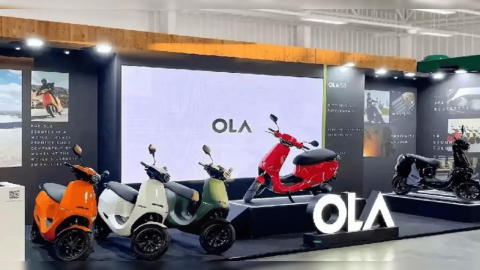Argument between Ola CEO Bhavish Aggarwal and Comedian Kunal Kamra Leads to 9% Decline in Ola Electric Share Price
An argument between comedian Kunal Kamra and Ola Electric CEO Bhavish Aggarwal on X (formerly Twitter) led to a decline of nearly 9 percent in share price of Ola Electric. Stock markets usually react quickly to news and this is exactly what happened with Ola Electric shares as Kamra raised an important issue of after-sales service of Ola Electric. Many consumers have complained about the issues they face and how the support usually gets delayed. Bhavish Aggarwal was quick to counter Kamra online but that issue caused worry among Ola investors. Ola Electric stock is currently trading at Rs 96 (quite close to its 52-week low of Rs 76) and we could see further decline in the stock in case a recovery above Rs 100 levels doesn't happen soon.
Ola Electric, once heralded as a trailblazer in India’s electric vehicle (EV) market, is now grappling with a range of operational and technical challenges. The company's stock has fallen over 40% from its peak, driven by a wave of customer complaints and a sharp decline in market share. With issues ranging from product defects to service delays, Ola Electric is under increasing pressure. Its market share has eroded rapidly, while established competitors like Bajaj and TVS are gaining ground. The situation calls into question the sustainability of Ola’s aggressive expansion strategy and its capacity to manage the fallout from these ongoing challenges.
Stock Performance Decline
Ola Electric's stock is enduring a sharp decline, despite trading above its August IPO price. After reaching a high of Rs 157, the share price has plummeted by more than 40%, hitting a low of Rs 96. This decline underscores a growing sense of unease among investors as the company faces both internal and external hurdles that threaten its market position.
Key takeaway:
The stock’s volatility reflects mounting investor concerns over the company's ability to manage its operational inefficiencies and customer dissatisfaction, despite the initial optimism following its IPO.
Customer Complaints Surge Amid Reliability Issues
Ola Electric is confronting widespread customer dissatisfaction, which is having a profound impact on the company's reputation.
Over 80,000 customer complaints per month: According to reports from Indian daily Mint, Ola receives an overwhelming number of complaints, particularly regarding the reliability and performance of its scooters.
Product issues: Major complaints include battery failures, software malfunctions, and handlebars locking up. Even customers with premium service plans face prolonged delays for repairs, with scooters sitting idle for weeks or months.
Regulatory scrutiny: In response to this surge in complaints, the Central Consumer Protection Authority (CCPA) issued a show-cause notice to Ola Electric, further compounding the pressure on the company.
Key takeaway:
Ola’s struggles with product reliability and service capacity are not only tarnishing its brand but also triggering regulatory action, which could escalate the company’s challenges.
Inadequate Service Infrastructure
Ola Electric’s rapid sales expansion has outpaced its ability to service its growing customer base, leading to significant service bottlenecks.
Underinvestment in servicing capacity: HSBC analysts noted that Ola did not adequately scale its service infrastructure to match its sales volume over the past two years.
Staff and equipment shortages: Many service centers are facing an acute shortage of skilled personnel and testing equipment, resulting in delays and a backlog of repairs.
Product development challenges: Analysts highlighted product issues, including sensor malfunctions, battery discharge problems, and software glitches. These problems, coupled with the service staff shortages, have compounded Ola’s operational inefficiencies.
Key takeaway:
Ola’s lack of investment in post-sales service capacity has led to an overwhelmed service network, unable to meet customer expectations or keep up with repair demands.
Rapid Decline in Market Share
Ola Electric's dominance in the EV market is fading rapidly.
Market share dropped from 49% to 27%: In just one quarter, Ola’s commanding lead in the EV market fell sharply from 49% in June to 27% by the end of September, as per Indian government data.
Competitors gain ground: Established automotive giants, Bajaj and TVS, have been ramping up their electric vehicle focus and now control more than 20% of the EV market each.
Key takeaway:
Ola’s rapid loss of market share, particularly to legacy players like Bajaj and TVS, underscores its weakening competitive position in the EV landscape.
Aggressive Expansion Strategy Backfires
Ola’s rush to dominate the EV market may have contributed to its current predicament.
Stretching resources too thin: The company’s aggressive expansion, coupled with global supply chain disruptions, resulted in production delays and component shortages, leading to cascading issues across its operations.
Impact on state-level dominance: Ola has lost its lead in five of the top ten states for electric vehicles, which collectively represent 80% of the total EV market. Furthermore, sales have dropped by over 50% compared to the start of FY25, indicating that service and product issues are impacting monthly sales.
Key takeaway:
Ola’s overextension in pursuit of rapid market share gains, exacerbated by global supply chain issues, has left the company vulnerable, leading to both operational inefficiencies and a sharp decline in sales.
Conclusion: Can Ola Recover?
Ola Electric faces a confluence of challenges that threaten its position as a leader in India’s EV market. With its stock plummeting, customer complaints soaring, and market share eroding, the company’s future looks uncertain. The rapid pace of its expansion appears to have backfired, leaving it with operational shortcomings and regulatory scrutiny. While Ola’s innovative approach initially gave it an edge, its ability to address these systemic issues will determine whether it can recover or cede further ground to competitors like Bajaj and TVS.
